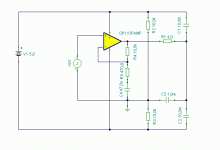I have Transformer 10amp 43-0-43v AC volt at secondary. I want to make a dual regulator power supply
for Amp +25v 0 -25v. I need 3 or 6amp dc output circuit.
The secondary voltage is really too high, and would cause high power dissipation in the regulator.
Are there dual primaries on the transformer? If so, what is your line voltage? You may be able to
series the primaries, and if you have a 120V line, you would get about the right voltage.
Last edited:
You could use a simple RCRC after your regulator - that would burn off at least some of the the extra volts that you don't need and significantly reduce the ripple. You could add a regulator afterwards if you needed to and it wouldn't need to work so hard.
Bottom line is that you have the wrong transformer and you are going to be burning off a lot of power as heat (and you'll need to get that heat out of your chassis).
Bottom line is that you have the wrong transformer and you are going to be burning off a lot of power as heat (and you'll need to get that heat out of your chassis).
Yason and rayma are right about very high dissipation in this solution, and there are other possible problems, so i don't recommend building a regulator in this situation.
There are many other possible solutions, but to chose the right one you need to tell the details: what is the amplifier like, what is the trafo like, are the secondaries separable, and what are the power ratings.
For example I built one of my amps with a single secodary trafo (40V), rectified by bridge, connected to 2 elcos in series, and used as a +/-26 V PSU, 0 provided by the common point of the elcos. To maintain DC balance I used the amplifier, biased with a small, filtered feedback from +/- voltage rails. It works fine for 10 years.
But if your amp is bridged, then you don't really need a center voltage, at least not a loadable one, so you can use a simple divider from 2 resistors and 2 smaller elcos along with the big puffer cap.
If you can reverse the phase one of your amps (both on inputs and outputs, so effectively speaker gets the same phase), then you can also account much smaller current on center voltage.
You can also provide a small center current with a second, small transformer with 2 uniform windings connected in series, and parallel to your 43V AC. (5-10 % of power rating of the bigger trafo can be enough if you use elcos big enough or your load is symmetric either because of bridge tied load or phase change on 1 channel).
Or you can wind a small 21.5 V secondary to your trafo. Connected in the proper phase to your paralleled original secondaries they will also provide +/- 28 V DC as long as load is not very asymmetric.
There are many other possible solutions, but to chose the right one you need to tell the details: what is the amplifier like, what is the trafo like, are the secondaries separable, and what are the power ratings.
For example I built one of my amps with a single secodary trafo (40V), rectified by bridge, connected to 2 elcos in series, and used as a +/-26 V PSU, 0 provided by the common point of the elcos. To maintain DC balance I used the amplifier, biased with a small, filtered feedback from +/- voltage rails. It works fine for 10 years.
But if your amp is bridged, then you don't really need a center voltage, at least not a loadable one, so you can use a simple divider from 2 resistors and 2 smaller elcos along with the big puffer cap.
If you can reverse the phase one of your amps (both on inputs and outputs, so effectively speaker gets the same phase), then you can also account much smaller current on center voltage.
You can also provide a small center current with a second, small transformer with 2 uniform windings connected in series, and parallel to your 43V AC. (5-10 % of power rating of the bigger trafo can be enough if you use elcos big enough or your load is symmetric either because of bridge tied load or phase change on 1 channel).
Or you can wind a small 21.5 V secondary to your trafo. Connected in the proper phase to your paralleled original secondaries they will also provide +/- 28 V DC as long as load is not very asymmetric.
From what I can tell you are building a class A design. "Burning off excess voltage" is the last thing you need to be lumbered with considering things will already be running hot under even ideal conditions. You really do need a more suitable transformer. Sell the one you have and use the money towards a better solution 
You are lucky, its input is symmetrical, so you can easily reverse the phase of one. (Unless you build 2 mono blocks...) In either ways, you don't need much DC or low freq. current, and some heat is not so worrying, so you can make rail splitter from 2 power resistors, for example 47 ohm 15 W on the DC rails. High capacitance is needed, 2*10000 uF at least (up to 2*100000 uF), and maybe CRC or CLC filter. If you use cap big enough, and set the DC offset "perfectly", then current of DC splitter can be reduced. An active DC splitter is more effective, but more complicated. Probably you don't need it.
- Status
- This old topic is closed. If you want to reopen this topic, contact a moderator using the "Report Post" button.
- Home
- Amplifiers
- Power Supplies
- Regulated Power supply for amp
